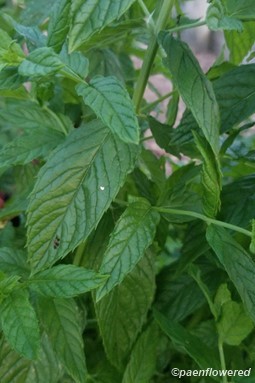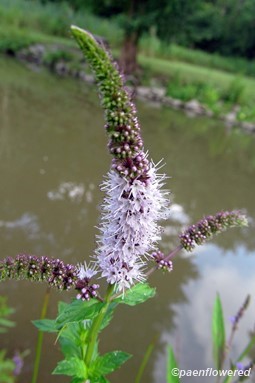Mentha spicata
Naturalized nonnative mint with fragrant leaves
Mentha spicata spearmint
This member of the mint family is native to Eurasia and was imported by early settlers to North America. The leaves have no stalks or almost no stalks (at most 1/8 inch). These leaves are long, pointed, toothed, and opposite on the stem. The pointed leaf tips give the plant its common name.
The flowers of spearmint are pale violet, pink or sometimes white. The stamens protrude from the flower corolla. Flower clusters are in the form of spikes at the ends of the stem or growing from the stems that arise from the upper leaf axils. The flowers bloom from the bottom of the spike progressively towards the top. The stems are erect and grow up to twenty inches high. They are less hairy than many other mints. Like most mints, the stem is square in cross-section. Branching at the top of the stem may produce multiple flower spikes.
Spearmint is a widespread species in both North America and Pennsylvania. It blooms from June to October. It is mostly found in wet places and like many mints grow into colonies from spreading underground rhizomes. It is a declared invasive species in Illinois and Tennessee. Spearmint is widely cultivated for use as a flavoring but is often grown in buried pots to prevent it from spreading too aggressively.
Spearmint leaves can be used fresh, dried, or frozen. They can also be preserved in salt, sugar, sugar syrup, alcohol, or oil. It is a common flavoring for chewing gum and can be used to make mint tea. The leaves lose their aromatic appeal after the plant flowers. Oil of spearmint can be extracted from the plant. This can be used as a fumigant against adult moths.
It is believed that peppermint (M. x piperita) is a hybrid between this species and water mint (M. aquatica). Peppermint has leaves with longer stalks than spearmint. This species is also called common Mint, lamb mint and mackerel mint.
Habitat & Range
Naturalized in stream banks, swamps, and wet pastures.
Present throughout the state.
| EMP: | FACW |
|---|---|
| NCNE: | FACW |
Phenology
Flowers June to October.









Comments
Have you spotted this plant in your area? We'd love to hear about your experience! Share your comments or questions about the plant below. Comments are moderated before posting.